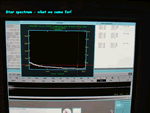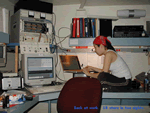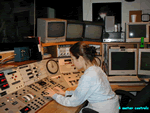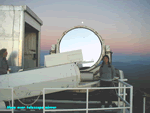JINA endeavors to involve students at all levels in activities related
to nuclear astrophysics. Recently, we have had one student, in particular,
who stood out with her desire and her abilities. Ms. Julie Krugler,
a senior at Grosse Point High School, Michigan, contacted JINA co-investigator
Timothy Beers in fall 2003, looking for a list of stars that might
prove useful for her project, as described below. Julie not only obtained
spectroscopic data for these stars, but carried the project through
all the steps of data reduction and analysis.
Julie presented the results of her research at the Detroit Junior Science and Humanities Symposium on March 4, 2004, placing fifth overall with her paper "In Pursuit of Population III." On March 30, she presented this research at the Science and Engineering Fair of Metropolitan Detroit. She was a Grand Award winner, and she presented her project at the International Science and Engineering Fair in Portland, Oregon on May 13th, where she placed second in the Priscilla and Bart Bok award from AAS/ASP and received $3000 and possibly a trip to the next ASP conference to present her project. She placed first in the Earth and Space Sciences category for the Air Force and won $3000. And, she also placed second in Earth and Space Sciences in the fair overall and won another $1500. Julie will be a freshman at MSU this fall.
Julie's summary of her project is given below. Julie's success is a wonderful example of "learning by doing," and we encourage other students and teachers to consider starting similar projects with JINA members in the future.
---------------------------------
In Pursuit of Population III (by Julie Krugler)
For the past six years, the Research-Based Science Education (RBSE) program administered by the National Optical Astronomy Observatories (NOAO, in Tucson) has been giving students (from middle school and high school) the opportunity to participate in research projects using real astronomical data gathered at Kitt Peak National Observatory (KPNO). Ms. Ardis Maciolek has been a member of the program since it began. In 2001 RBSE enlarged to include a Teacher Leaders in Research Based Science Education (TLRBSE) component, which is a classroom-enrichment program to help teachers integrate astronomical research in the classroom. I took part in this program through a project called Nova Search in which CCD images taken at Kitt Peak were analyzed for nova outbursts by members of our high school astronomy classes.
All of the data for the many TLRBSE programs had been taken by astronomers until this past year. Recently, TLRBSE opened the observing program to provide students and teacher groups the chance to obtain their own data. I helped to develop a proposal to use the Coude Feed Spectroscope at KPNO to search for metal-poor stars as possible Population III candidates. The stars studied were mainly spectral types G and K, because these stars have life spans which are long enough to have potentially been around since the very beginnings of the universe.
Ours was the first proposal accepted. This past November Ms. Maciolek, Amelia Altavena, and I went to KPNO to observe for two (fortunately) cloudless nights. We ran the telescope operations and performed our own calibrations with the help of KPNO astronomer Steve Howell. In the end, we had taken the spectra of about twenty stars which were put on CD and taken home, which is where all the work really began.
The data reduction was a two-part process, one on the mountain, and the other on computers back at our school. The calibrations corrected the CCD camera for the wavelength range (3800-5000 Å) which my study covered. It also corrected for pixel flaws. At home, I corrected my stars for redshift since my stars were of the halo and had high radial velocities. Once this was completed I normalized my spectra for analysis using EXCEL.
Analysis was also two-fold. I analyzed my stars for abundances and attempted to more precisely classify them. In order to calculate the abundances of metals in my stars, I created a model star using the Vienna Atomic Line Database (VALD). VALD creates model stars based on the microturbuelence, the surface gravity, the temperature, and abundances of elements in the star. The types of information given about the star are the specific elements at each wavelength and the central depths of these lines. I used these model stars to calculate the iron-to-hydrogen and titanium-to-hydrogen ratios. These ratios are common indicators of metallicity. Most of my stars were metal-deficient in comparison with the sun.
The second part of my analysis came with the re-classification of several stars. All of the stars (with the exception of one) were taken from the Henry Draper Catalogue. The most recent HD survey took spectra with a resolution of 2 Å. The resolution of the spectra I took at Kitt Peak were a bit higher, on the order of 1 Å. The clearer look at these stars allowed me to make more precise spectral classifications. Many changed only over a few subclasses, whilst others were assigned a new, or their first, luminosity class. One star was found to be a carbon star, whilst another had been classified a K0, but appeared to be a G0. These disparities and oddities are seeds for further investigation.
Concluding these results, I believe that G and K stars are legitimate candidates for Population III stars, and may be useful for documenting the histories of the first stars.
In future endeavors, I plan analyze the carbon and nitrogen abundances
of my stars, and also see if they are possibly r-process enhanced.
I am also considering making another proposal to use the Coude Feed
Spectroscope once more in order to obtain higher resolution spectra.









